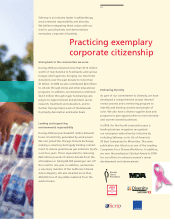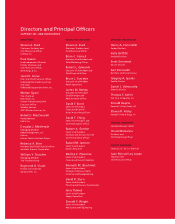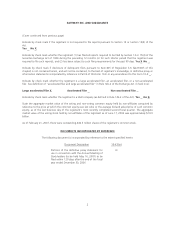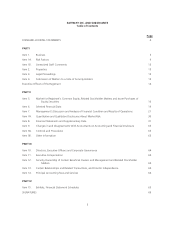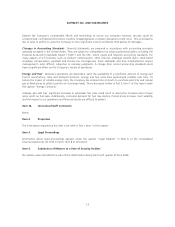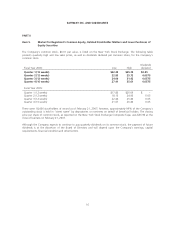Safeway 2006 Annual Report Download - page 26
Download and view the complete annual report
Please find page 26 of the 2006 Safeway annual report below. You can navigate through the pages in the report by either clicking on the pages listed below, or by using the keyword search tool below to find specific information within the annual report.SAFEWAY INC. AND SUBSIDIARIES
During 2006 Safeway invested $1.67 billion in cash capital expenditures. The Company opened 17 new Lifestyle
stores, remodeled 276 stores to the Lifestyle format and closed 31 stores. The Company also completed eight other
remodels. In 2007 the Company expects to spend approximately $1.7 billion in cash capital expenditures and open
approximately 25 new Lifestyle stores while completing some 275 Lifestyle remodels. At year-end 2006, 43% of
Safeway’s store base was in the Lifestyle format, and the Company expects to have approximately 60% in this format
by the end of 2007. By the end of 2009, the Company expects that the Lifestyle rollout will be largely complete.
Financial Information about Segments Note L to the consolidated financial statements set forth in Part II, Item 8
of this report provides financial information about the Company’s segments.
Trade Names and Trademarks Safeway has invested significantly in the development and protection of “Safeway”
both as a trade name and a trademark and considers it to be an important asset. Safeway also owns more than 450
other trademarks registered and/or pending in the United States Patent and Trademark Office and other jurisdictions,
including trademarks for its product lines such as Safeway, Safeway SELECT, Rancher’s Reserve, OORGANICS,
Lucerne, Primo Taglio, Eating Right, Basic Red and Priority, and other trademarks such as Pak’N Save Foods, Vons,
Pavilions, Dominick’s, Randall’s, Tom Thumb, Genuardi’s and Carrs Quality Centers. Each trademark registration is for
an initial period of 10 or 20 years, depending on the registration date, and may be renewable so long as it is in
continued use in commerce.
Canada Safeway also has registered numerous trademarks in Canada. Canada Safeway also has invested significantly
in “Safeway” both as a trade name and a trademark and considers it to be an important asset in Canada. Canada
Safeway owns and has registered in Canada more than 175 trademarks, most of which replicate trademarks owned in
the United States by Safeway. In addition to those trademarks used in common with Safeway, Canada Safeway owns
certain trademarks unique to its business in Canada. For example, Canada Safeway has registered the trademarks
“Macdonalds Consolidated” and “Family Foods” in connection with wholesale distribution of merchandise to
independent grocers. In Canada each trademark registration is for an initial period of 15 years, and may be renewed
for additional periods of 15 years, as long as the trademark continues to be used in commerce.
Safeway considers its trademarks to be of material importance to its business and actively defends and enforces its
rights.
Working Capital At year-end 2006, working capital consisted of $3.6 billion in current assets and $4.6 billion in
current liabilities. Normal operating fluctuations in these substantial balances can result in changes to cash flow from
operations presented in the consolidated statements of cash flows that are not necessarily indicative of long-term
operating trends.There are no unusual industry practices or requirements relating to working capital items.
Seasonality Blackhawk receives a significant portion of the cash inflow from the sale of third-party gift cards late in
the fourth quarter of the year and remits the cash, less commissions, to the card partners early in the first quarter of
the following year.
Competition Food retailing is intensely competitive. The number of competitors and the amount of competition
experienced by Safeway’s stores varies by market area. The principal competitive factors that affect the Company’s
business are location, quality, service, price and consumer loyalty to other brands and stores.
Local, regional and national food chains, as well as independent food stores, comprise the Company’s principal
competition. Safeway also faces substantial competition from dollar stores, convenience stores, liquor retailers,
restaurants, membership warehouse clubs, specialty retailers, supercenters, and large-scale drug and pharmaceutical
chains. Safeway and its competitors engage in price competition which, from time to time, has adversely affected
operating margins in the Company’s markets.
Raw Materials Various agricultural commodities constitute the principal raw materials used by the Company in the
manufacture of its food products. Management believes that raw materials for its products are not in short supply,
and all are readily available from a wide variety of independent suppliers.
8



